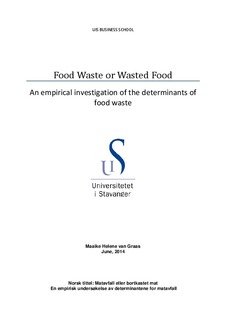| dc.contributor.author | van Graas, Maaike Helene | |
| dc.date.accessioned | 2014-09-03T08:13:33Z | |
| dc.date.available | 2014-09-03T08:13:33Z | |
| dc.date.issued | 2014-06-16 | |
| dc.identifier.uri | http://hdl.handle.net/11250/218616 | |
| dc.description | Master's thesis in Economic Analysis | nb_NO |
| dc.description.abstract | In the industrialized world large amounts of food are daily disposed of. A significant share of this waste could be avoided if different choices were made by individual households. Each day, every household makes decisions to maximize their happiness while balancing restricted amounts of time and money. Thinking of the food waste issue in terms of the consumer choice problem where households can control the amount of wasted food, we can model how households can make the best decisions.
In this thesis, the food waste issue has been investigated through empirical research. A preliminary survey mapped the respondents’ habits on the topics of planning, shopping, and wasting food in addition to their background and lifestyle. Secondly, a weight form recording the amount of food waste, both edible and inedible, was filled out each day for 13 weeks. Together, this information formed a panel data set with 1400 observations.
The results from an extensive series of regressions show that the main variables affecting the amount of food waste are various planning variables, the level of education and income, household size, immigrants and diet. The frequency at which households eat leftovers before cooking new food is a behavioral variable which is significant. the amount of edible food waste is affected the number of days that households shop for, as it is shown that shopping for multiple days leads to lower amounts of edible food waste. These findings are consistent with the hypothesis. With regard to total food waste the regressions revealed that households with less fruit and vegetable waste after consumption have higher amounts of food disposal, which contradicts the hypothesis about that planning leads to less food being wasted. The education is consistent with the expectation that higher education leads to less food waste, however, the squared variable show a turning point around a level of education at a bachelor’s degree. The income variable tells the same story as education, but here the turning points lies at a yearly income of $ 67,500. The expectation that increased income leads to increased amounts of food waste is not exactly as the result. | nb_NO |
| dc.language.iso | eng | nb_NO |
| dc.publisher | University of Stavanger, Norway | nb_NO |
| dc.relation.ispartofseries | Masteroppgave/UIS-SV-HH/2014; | |
| dc.rights | Attribution-NonCommercial-NoDerivs 3.0 Norway | * |
| dc.rights.uri | http://creativecommons.org/licenses/by-nc-nd/3.0/no/ | * |
| dc.subject | økonomi | nb_NO |
| dc.subject | administrasjon | nb_NO |
| dc.subject | økonomisk analyse | nb_NO |
| dc.title | Food waste or wasted food | nb_NO |
| dc.title.alternative | Matavfall eller Bortkastet Mat | nb_NO |
| dc.type | Master thesis | nb_NO |
| dc.subject.nsi | VDP::Social science: 200::Economics: 210::Economics: 212 | nb_NO |

